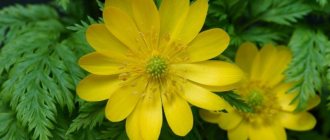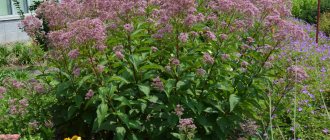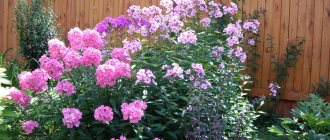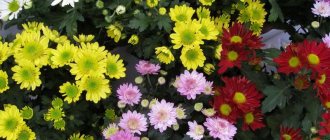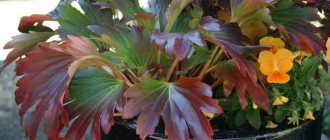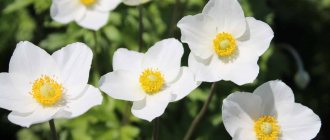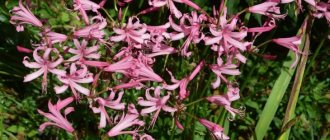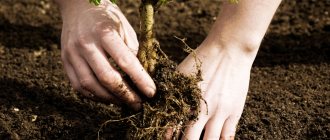Author: Natalya Category: Garden plants Published: February 24, 2019Republished: February 24, 2019Last edits: November 03, 2020
- Growing conditions
- How and when to collect seeds
- Echinacea purpurea
- Beneficial features
flower (lat. Echinacea) belongs to the genus of perennials of the Asteraceae, or Asteraceae, family, which includes 9 species. Echinacea is native to eastern North America. From Greek, the name of the plant is translated as “hedgehog, or prickly, like a hedgehog.” The most famous species in the genus is Echinacea purpurea, also known as rudbeckia purpurea, which is widely used in folk and traditional medicine, as well as in ornamental gardening. Echinacea was first described by Carl Linnaeus in 1753, assigning it to the genus Rudbeckia, but forty years later Echinacea was separated into a separate genus because noticeable differences were discovered between the two plants.
Planting and caring for Echinacea
- Planting: in spring or autumn.
- Flowering: from July to September.
- Lighting: bright sunlight.
- Soil: dryish, nutritious, well cultivated, containing a small amount of lime.
- Watering: frequent and abundant, in the evening.
- Top dressing: rotted compost with ash twice a season: in spring and autumn.
- Reproduction: by dividing the bush in April or during leaf fall. Echinacea species can be propagated by seeds.
- Pests: bedbugs, slobbering pennies and slugs.
- Diseases: powdery mildew, cercospora blight, septoria blight, viral infections.
Read more about growing echinacea below.
Sowing in open ground
You can sow seeds twice a year: at the very beginning of spring or at the end of autumn.
To do this, you need to treat the bed in advance: dig it up, make grooves about 1-2 cm deep. The optimal width between rows should be from 25 to 30 cm. Seeds should not be sown densely. After completing the procedure, cover them with a small amount of soil and be sure to water them. When the first sprouts appear, the plants are thinned out so that there is a distance of 7-8 cm between them; the second time, gaps of 10-15 cm are left. There should be a space of 40-50 cm between adult specimens. If the Echinacea varieties are small-growing, then from 20 to 30 cm. All specimens that remain after such thinning are simply transplanted to another, free place.
The first season after sowing, Echinacea grows and strengthens its roots, so it will bloom the next summer.
Botanical description
Echinacea is a perennial herbaceous rhizomatous plant with straight, rough stems reaching a height of 1-1.5 m. The basal wide oval leaves of Echinacea, jagged along the edges, are located on long petioles, and the stem leaves are lanceolate, alternate, sessile or almost sessile. The inflorescences consist of large baskets, which in turn are composed of marginal reed flowers of red, white or pink and central tubular flowers, red-brown or dark red. The fruit of Echinacea is a tetrahedral achene.
Planting Echinacea
When to plant
Echinacea is planted both in spring and autumn. The process is usually preceded by a procedure such as dividing an echinacea bush. You can, of course, grow the plant from seeds, but the generative method of propagation is used exclusively for growing species Echinacea; hybrid varieties are propagated vegetatively. So, find a bright, lit place for Echinacea with fertile, deeply cultivated neutral or slightly alkaline soil - too wet or light sandy soils will not suit Echinacea. If the soil on the site is acidic, you will have to add lime to it.
How to plant
Holes for echinacea are dug 5 cm deep at a distance of 30 cm from each other - this is for planting seedlings, and for divisions the depth of the hole should be slightly greater than the root system of the seedling. Place some compost at the bottom of the holes, and only then plant echinacea. After planting, the area is watered. If your planting material is in a container, then the hole should be larger, about 40 cm. Fill it one third with a mixture of sand, compost and garden soil in equal proportions, and then carefully transfer the seedling into the hole along with the earthen ball, fixing it at that depth , on which he grew in a container.
- Planting marigolds for seedlings
Perennial propagation
Echinacea is propagated in three ways:
- seeds;
- dividing the bush;
- cuttings.
Seed method
This method allows you to grow new varieties and propagate your favorite ones. Seeds are sown in open ground both in autumn and spring. They will germinate best at a temperature of +12 degrees. Spring sowing is done early so that before frost sets in, the plant is stronger and ready for winter. Seeds sown in autumn will survive the winter and grow the healthiest and strongest.
Borings that have barely emerged from seeds sown in open ground are too weak and fragile for changeable spring weather, so it is better to plant seedlings. For seedlings, sowing is carried out in February-March in containers.
Shrub division method
The procedure is carried out in the spring in April or in the fall, when the leaves fall. The first time they divide a shrub that is 4-5 years old. First, they take it out of the pot, carefully digging it up, trying not to damage the root system. Divide into parts with 3-4 growth buds and place the divisions in a stimulating solution. After two hours they are planted in the ground. When planting, the neck should not be deepened too much; it should be closer to the surface of the earth.
Cuttings
This propagation method is quite complex and does not always lead to good results. The best time for cuttings is June. Choose strong, healthy stems. When cutting cuttings, leave two leaves on each. The sections are moistened with a root stimulating agent.
The treated planting material is planted in containers filled with fertile, moist soil. At home, the temperature is maintained at 22 to 25 degrees. By the new leaves that appear again, one can judge the formed root system. After two months, the plant will finally take root and become stronger. After this, it is planted in open ground.
Caring for Echinacea in the Garden
Growing conditions
Growing echinacea is not at all tedious, but it still requires attention. Firstly, Echinacea needs to be watered frequently and abundantly, and it is better to do this in the evening. But the most important thing is to keep the area clean - remove weeds as soon as they appear. From the second year of life, Echinacea needs to be fertilized with rotted compost with ash - this will give it the opportunity to bloom more luxuriantly. Fertilizers are applied twice per season: in spring and after flowering. If you don't need the seeds, cut off the spent inflorescences with part of the stem back to the first green leaf.
Echinacea propagation
Most often, Echinacea is propagated by dividing the bush, especially since this can be done both in the spring in April and in the fall during leaf fall. You can divide an Echinacea bush for the first time when it is 4-5 years old. The plant must be dug up carefully so as not to damage the rhizome, then the bush is divided so that 3-4 renewal buds remain in each part. Planting of cuttings is carried out in the same order and according to the same rules as the primary planting.
Species echinacea, as already mentioned, is propagated by seed. Large Echinacea seeds are sown directly in open ground in the spring, since they germinate best at a temperature of 13 ºC. After sowing, the seeds are lightly sprinkled with a thin layer of garden soil. But it is better to grow seedlings from seeds, since barely hatched echinacea seedlings are too tender and fragile for unstable spring weather.
Sow the seeds in February-March in boxes or containers to a depth of half a centimeter, lightly sprinkle them with soil on top and moisten the sowing with a sprayer. Germination, even at the optimal temperature for echinacea, will have to wait a long time, sometimes up to a month and a half, but when the seedlings appear, grow and become stronger, they are planted in open ground, after which caring for them consists of watering, weeding and loosening the soil in the area.
In the first year, Echinacea grown from seeds will not bloom, it will only grow a rosette of leaves 15-20 cm high, but next season you will certainly see charming flowering and hear the pleasant aroma of Echinacea exuded by its inflorescences.
Pests and diseases
The plant rarely gets sick, and all its troubles usually happen due to improper care. In hot summers with frequent rains and temperature fluctuations, as well as from too much nitrogen fertilizing, Echinacea can develop powdery mildew - a dangerous whitish coating will appear on the shoots, leaves and flowers. The fungus can be destroyed by treating Echinacea with colloidal sulfur or Bordeaux mixture.
- Irises in the garden
Sometimes Echinacea suffers from fungal diseases septoria and cercospora, which appear as spots on the leaves, weakening the plant and leading to its death. If the disease is detected at an early stage, you can save the echinacea by removing the affected areas, but if the disease has taken hold, you will have to resort to treating the plant with fungicides.
It happens that echinacea is affected by viral diseases, from which the flower stalks are deformed, the leaves of the plant turn yellow and dry. Sick specimens must be urgently removed from the site and burned, and the place where they grew must be disinfected with a strong solution of potassium permanganate. There is no cure for viral diseases yet.
Sometimes bugs, slugs and slobbering pennies damage Echinacea. It is better to collect slugs by hand, and as a preventive measure, you can scatter nut shells over the area, which will prevent gastropods from moving. Insects are destroyed with insecticides - Actellik or Karbofos.
All these troubles are very easy to avoid if you strictly follow the conditions of the plant’s agricultural technology, especially since planting and caring for echinacea in the open ground is not so burdensome.
How to plant a perennial plant
The lifespan of Echinacea is about 5 years. For growing, you need to choose open sunny areas. Slightly alkaline fertile soil is suitable. The plant can be propagated by seeds or seedlings.
Planting is done in autumn or early spring. In nature, Echinacea reproduces by self-sowing, dropping seeds into the ground in the fall so that sprouts appear in the spring.
Having chosen a seed planting path for a plant, you should do the same. This method is not reliable as some seeds may be of poor quality. Therefore, it is much safer to plant using seedlings previously grown in containers with a nutrient mixture.
Flowers appear in the second year after planting and bloom for about 60 days. It is important to strive to ensure that the plant is strong and healthy. Then it can serve as a good honey plant for bees, and its medicinal properties will manifest themselves most clearly.
Seed preparation
In order to get strong seedlings, the seeds must first be prepared. The grains are placed in cotton wool or a thin cloth and filled with water so that it completely covers the cloth. After some time, the seeds will germinate, after which they can be planted.
Timing and technology of sowing
Before growing in open ground, hatched seeds must be planted in individual containers with a nutrient medium. You should fill the cups with soil, make holes in them and place the sprouted seeds there. Immediately after planting, future seedlings should be watered abundantly. The process of seed germination can last a long time - up to 1.5 months.
Transplanting seedlings into open ground
Transplantation of seedlings into open ground is carried out in May-June. In the selected location, dig holes according to the number of sprouts at a distance of 25-30 centimeters. Before planting, you should fertilize the soil by placing a mixture of garden soil and compost at the bottom of the hole, and after planting, thoroughly water the seedlings.
In the future, you will need to maintain moderate humidity, constantly weed and loosen the soil.
Echinacea after flowering
How and when to collect seeds
Echinacea seeds are collected at the end of the season, when they ripen on the bushes. However, they do not all ripen at once, so the seeds are collected gradually. When you see that the middle of the flower has darkened, put a glove on your hand and collect the seeds from the center of the basket, then clean them of the remains of tubular flowers and dry them. Echinacea seeds quickly lose their viability, so it is better to sow them right away.
Preparing for winter
Echinacea is a fairly cold-resistant plant, but in too frosty and snowless winters it can freeze. Cold weather is especially dangerous for plants in their first year of life. To prevent the echinacea from dying, cut off all its stems at the end of October, mulch the root collar with compost, and then cover the area with the echinacea with dry leaves or spruce branches.
What are the benefits of Echinacea flowers?
The benefits of a medicinal plant for the human body are as follows:
- Strengthens immune status.
- Natural antioxidant.
- Has an anti-inflammatory effect.
- Has regenerative ability against ulcers, wounds and burns.
- Antibacterial and antiviral properties.
Due to natural hormone-like substances, Echinacea is essential for women. It improves the menstrual cycle, relieves pain, and normalizes general hormonal levels.
For men, grass is also important. Thanks to its unique composition, the state of the cardiovascular system, immunity is strengthened and inflammatory processes of the prostate are prevented.
For school-age children, Echinacea in the form of tea or infusion helps increase the body's susceptibility to diseases, improve concentration, memory and give energy.
Types and varieties
There are nine species of Echinacea in nature, but most of the cultivated plants of this genus are varieties and hybrids of Echinacea purpurea.
- Varieties of lilies
Echinacea purpurea
A perennial plant reaching a height of 100 cm. Its stems are straight, rough, the basal leaves are broadly oval, sharply tapering to long winged petioles, collected in a rosette, the stem leaves are also rough, lanceolate, alternate, sessile. The basket inflorescences consist of purple-pink reed flowers up to 4 cm long, pointed towards the apex; tubular flowers located in the middle are red-brown. The best varieties:
- Pomegranate - coneflower up to 130 cm high with baskets 13 cm in diameter with slightly drooping purple reed flowers with two teeth at the top and brown tubular flowers forming a convex hemisphere up to 4 cm in diameter;
- Sonnenlach - the height of this plant is about 140 cm, baskets up to 10 cm in diameter consist of dark red lanceolate reed flowers up to 3.5 cm long, ending with two or three teeth, and a convex brown hemisphere of tubular flowers.
Echinacea x sunset
A series of hybrids between Echinacea purpurea and paradoxical, bred by Richard Skol. These hybrids combine all the best qualities of both types - large basket sizes, curved petals, strong branching stems, exquisite colors of mango, mustard, peach, strawberry, amazing aroma. The tubular petals are the color of henna.
As a result of intensive breeding work, varieties with purple, white, orange, pink, yellow and reddish inflorescence colors have been developed. We offer you the most popular varieties of garden echinacea:
- Julia - belongs to the “Butterfly Kisses” variety series. Reaching only 45cm in height, this dwarf coneflower has bright orange flowers that open in early summer and last until the end of the season;
- Cleopatra - the variety is named after the bright yellow butterflies. This is a plant with bright yellow baskets up to 7.5 cm in diameter with horizontally arranged reed flowers - they look like the sun in a child’s drawing;
- Evening Glow - blooms in baskets with yellow reed flowers with an orange stripe with a pinkish tint, the middle of tubular flowers protrudes as a dark cone;
- Musk Melon - has the color of this particular vegetable: a double row of reed petals looks like a pinkish-orange frill, and darker tubular flowers form a shaggy hemisphere;
- Passion Flute is an unusual echinacea: the reed flowers twisted into a tube are golden-yellow in color, and the tubular center is a greenish-mustard hue. This variety belongs to the Let's Buggy variety series; it is drought-resistant and unpretentious in care;
- Double Scoop Cranberry is an easy-to-care, drought-tolerant cranberry-colored beauty that is eye-catching and butterfly-attracting—it's incredible in a bouquet.
Properties of Echinacea - benefits and harms
Beneficial features
Echinacea herb contains polysaccharides, flavonoids, tannins, saponins, hydroxycinnamic and organic acids, phytosterols, resins and essential oils. The rhizome also contains essential and fatty oils, resins, enzymes, macroelements in the form of potassium and calcium, and microelements selenium, silver, zinc, manganese, molybdenum and cobalt.
Preparations from Echinacea purpurea have antiviral, antimicrobial, wound-healing and antifungal effects, strengthen the immune system, and help with physical and mental fatigue. By drugs we mean juice, decoctions, tinctures and extracts of Echinacea purpurea. Tincture, for example, has the property of healing burns and increases potency. In folk medicine, juice from fresh inflorescences of the plant is used to treat wounds, and internal use accelerates blood clotting.
Echinacea purpurea is popular in many countries. In Germany, the drug echinacin is used to treat sore throat, tonsillitis, chroniosepsis and other inflammatory diseases. In Russia, Professor S.A. became the popularizer of this valuable plant. Tomilin, who believed that the medicinal properties of echinacea are not inferior to those of ginseng. We offer you recipes for echinacea preparations that you can prepare yourself.
Tincture: cut the Echinacea flowers, fill them with a half-liter jar with a twist lid, fill them to the top with vodka, twist the jar and put it in a dark place for 40 days, then drain the contents and drink 15 drops per third of a glass of water or tea per day. half an hour before meals for depression, fatigue and infectious diseases.
Decoction of roots: pour a tablespoon of crushed roots with water in the amount of 300 ml, boil in a water bath for half an hour, leave to brew until completely cooled, strain and take 1-2 tablespoons 3-4 times a day before meals for chronic fatigue, colds and acute infectious diseases.
Contraindications
Echinacea preparations can cause allergies in some people. It is not recommended to use them for pregnant and breastfeeding women, as well as for those with leukemia, multiple sclerosis, collagenosis, progressive tuberculosis or individual intolerance to drugs from the plant. For those who do not have such contraindications, we recommend that you consult a doctor before using echinacea medications.




